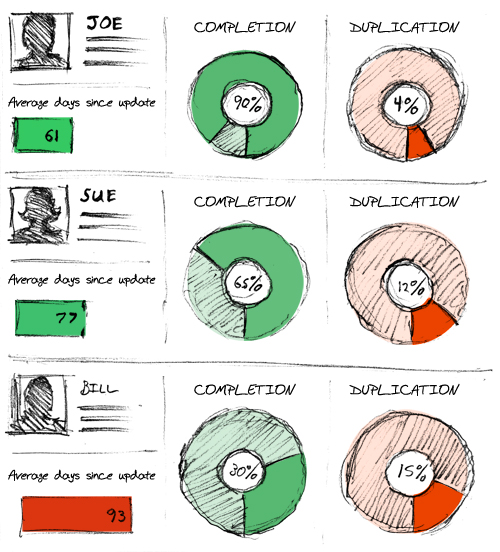Hack:
Is Gamification the Key to Adoption of Sales Force Automation Software?
March 30, 2011 at 2:16pm
Moonshots
Summary
The sales force automation (SFA) software market is growing rapidly, with companies such as Salesforce.com becoming dominant players in the enterprise software space. And yet, adoption of these systems is notoriously low. Recently, there has been research in the field of gamification for using game mechanics to solve business problems. So, what if you could apply gaming mechanics to SFA software to increase adoption by the sales force?
Problem
A report from the Journal of the Academy of Marketing Science shows a staggeringly high failure rate for SFA tools: 75%. Why? Rejection of the new technology by the sales force.
Recently, there has been a lot of research in the area of gamification: the process of adding gaming elements to a non-gaming activity to encourage action and participation. In fact, the first Gamification Summit took place in January this year in San Francisco. Thought leaders and eExperts in the fields of game mechanics and engagement science met to discuss how to use game mechanics and game thinking gaming to solve business problems.
That got me thinking, cCould gamification also be used to makeimprove the adoption of SFAsales force automation (SFA) software more enticing to sales teams? It seems logical that gaming elements would appeal to sales people-- - a notoriously competitive bunch-- - and get them more engaged with the software. Is it time for SFA vendors to dust off those consoles and get their game on?
Recently, there has been a lot of research in the area of gamification: the process of adding gaming elements to a non-gaming activity to encourage action and participation.
That got me thinking, could gamification also be used to improve the adoption of sales force automation (SFA) software more enticing to sales teams? It seems logical that gaming elements would appeal to sales people--a notoriously competitive bunch--and get them more engaged with the software.
I decided to look at three problems in particular:
- motivation
- data quality
- productivity
Then, I brainstormed ways in which the application of game mechanics could address these issues.
Solution
To address the issue of motivation, I suggested creating a leader board with badges. Badges are used as signs of achievement. Whenever a staff member completes a certain level of training on the SFA software, they receive a badge that appears on their profile. The profile is visible to the individual user, as well as the rest of the team. Displaying your profile provides a sense of self-satisfaction and accomplishment. It is also a motivational tool, reminding you of what other training badges you need in order to keep up with your peers. Additional incentives could be tied to the badges as well. For example, a sales rep might receive a 25% increase in commission rates for receiving an important badge.
When users have not adopted the system or have not been fully trained, incomplete or duplicate records are a common occurrence. To address this, I thought creating a visual representation of an individual's data cleansing efforts might be particularly useful. The system would measure the level of record completion and duplication for each user. It would also display the average number of days since they have updated their records. This keeps data cleanliness at top-of-mind for users. Based on performance, users could be ranked, which taps into the reps' competitive nature. This simple addition of gaming mechanics turns a repetitive, menial task into a challenge. And who doesn't love a challenge?
Another menial task is making sales calls. No one likes to do it, but it’s absolutely necessary. In order to enhance performance on this daily task, the system would track users’ total calls and qualified leads for the month in a graph. This puts productivity in a visual form relative to their peers. Users can actually see their progress and make decisions on what they need to do to reach their monthly quota. There would also have to be an option for organizing this based on level of seniority. For example, you would not want the “newbies” going up against the sales vets, as it would be an unfair match-up. With the ability to customize based on level of seniority, users would only see themselves in comparison to other team members at their level. This provides a more accurate ranking, and keeps sales reps motivated at every level.
For visuals of these, check out the Software Advice article on adding gamification to SFA.
Practical Impact
Dr. Michael Wu, a gamification guru at Lithium, a company that hosts social community platforms, describes the term as “the use of game mechanics to drive game-like engagement and actions.” It’s simple, really. People love to play games, but their daily lives are filled with boring or taxing activities. Gamification is the process of incorporating game mechanics (points, awards, status, etc.) into these activities, making them more game-like, and thus more appealing.
Gaming mechanics are basically the building blocks of gamification. WTo quote Dr. Wu again, they are “principles, rules, and/or mechanisms that govern a behavior through a system of incentives, feedback, and rewards with reasonably predictable outcomes.” ith gamification, different sets of gaming mechanics come together to stimulate action. The reason this works is because, on a very basic level, these mechanics appeal to core human needs:
Need
Gaming Mechanic
Reward
Points
Status
Levels
Achievement
Challenges
Competition
Leadership Boards
Also, because these needs are consistent rather than situational, you can pretty much incorporate gamification into anything.
The reason why this will work is really quite simple. People love to play games, but their daily lives are filled with boring or taxing activities. Gamification is the process of incorporating game mechanics (points, awards, status, etc.) into these activities, making them more game-like, and thus more appealing. With gamification, different sets of gaming mechanics come together to stimulate action. The reason this works is because, on a very basic level, these mechanics appeal to core human needs:
- Points appeal to our need for rewarda
- Levels appeal to our desire of status
- Challenges appeal to our longing for achievement
- Leadership Boards appeal to our sense of competition
First Steps
Unfortunately, there is no test yet because the software doesn't exist yet. However, after publishing an article on this topic, my company, Software Advice, heard a lot of buzz around the community. There is talk of an app being built for Salesforce that would gamify certain aspects of the system. However, it's all just talk until someone actually does something. Rather than presenting first steps, I present a challenge to the software engineers out there to come up with a sophisticated SFA system that incorporates gaming mechanics into the processes of the software. And when you do, call me.
Images





You need to register in order to submit a comment.